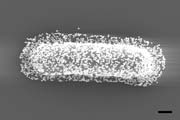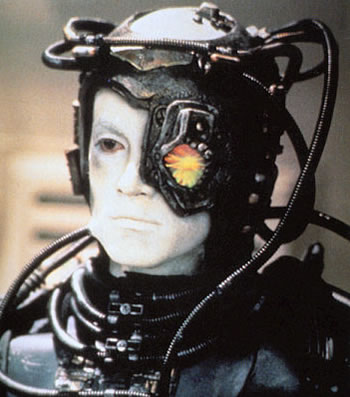Science Fiction
Dictionary
A B C D E F G H I J K L M N O P Q R S T U V W X Y Z
'Cellborg' Humidity Gauge First Bacterial Cyborg

Chemists at the University of Nebraska have created a humidity gauge by actually 'assimilating' living bacteria into an electronic circuit. This appears to be the first instance in which a living cell becomes a fixed part of the structure of an electronic device.

('Cellborg' - first bacterial cyborg)
Ravi Saraf and student Vikas Berry made their device from a standard silicon chip inlaid with gold electrodes. First they added a coating of Bacillus cereus bacteria, which clustered together to form bridges between the electrodes. Then they washed the chip with a solution of gold particles, each of which measured about 30 nanometres across and was covered with peptides to help it stick to the bacteria.
A rise in moisture levels causes the bacteria to swell slightly, which increases the distance between neighbouring nanoparticles by up to 0.2 nanometres. This tiny separation makes it harder for electrons to hop from one particle to the next, which reduces the current flowing across the chip. A change from 20% to 0% humidity increased the current flowing through the device by 40 times, whereas the current in a solely electronic device decreases by just ten times.
The bacteria must stay alive during their assimilation so that they do not leak any internal fluids and lose their shape. According to Saraf, the bacteria can survive for about two days without nutrients. However, the device continues to work even after the bacteria die; the zombie 'borg-teria' continue to work for as long as a month after death.

(Hugh - the Borg drone)
Science fiction fans are well aware of the 'cellborgs' namesake - the Borg collective of cyborgs (cybernetic organisms) who stop at nothing in their relentless pursuit of assimilating other intelligent organisms.
In the series (and associated films), captured human beings are outfitted with mechanical and electrical parts that will make them serviceful to the collective.
Saraf speculates that similar devices could one day be made that take greater advantage of living organisms, perhaps even using bacteria's energy systems to power electrical devices. But that will involve going one step further: using a physiological rather than physical response of a bacteria. "One still needs to demonstrate that an electronic coupling between the biology of the microorganism and a nanodevice is possible," he adds.
Read Cyborg cells sense humidity.
Scroll down for more stories in the same category. (Story submitted 10/18/2005)
Follow this kind of news @Technovelgy.| Email | RSS | Blog It | Stumble | del.icio.us | Digg | Reddit |
Would
you like to contribute a story tip?
It's easy:
Get the URL of the story, and the related sf author, and add
it here.
Comment/Join discussion ( 3 )
Related News Stories - (" Medical ")
Natural Gait With Prosthetic Connected To Nervous System
'The leg was to function, in a way, as a servo-mechanism operated by Larry’s brain...' - Charles Recour, 1949.
Brain Implant Is Able To Capture Your Inner Dialogue
'So you see, you can hide nothing from me.'
'Pregnancy Humanoids' From China Replace Moms
'A great many of these synthetic babies were made...' - David H. Keller, 1928.
Bacteria Turns Plastic Into Pain Relief? That Gives Me An Idea.
'I guess there's nobody round this table who doesn't have a Crosswell [tapeworm] working for him in the small intestine.'
Technovelgy (that's tech-novel-gee!) is devoted to the creative science inventions and ideas of sf authors. Look for the Invention Category that interests you, the Glossary, the Invention Timeline, or see what's New.
Science Fiction
Timeline
1600-1899
1900-1939
1940's 1950's
1960's 1970's
1980's 1990's
2000's 2010's
Current News
Natural Gait With Prosthetic Connected To Nervous System
'The leg was to function, in a way, as a servo-mechanism operated by Larry’s brain...'
Woman Marries Computer, Vonnegut's Dream Comes True
'Men are made of protoplasm... Lasts forever.'
Spidery 'Walk Me' Toyota Autonomous Wheel Chair Like Star Wars
Walk along with the emperor.
Dancing Robots Taught Dance Moves
'A clockwork figure would be the thing for you...'
Proof Of Robothood - Not A Person
'Who are you people? - Show 'em.'
Indonesian Clans Battle
'The observation vehicle was of that peculiar variety used in conveying a large number of people across rough terrain.'
The 'Last Mile' In China Crowded With Delivery Robots
Yes, it's a delivery robot. On wheels.
Tornyol Microdrone Kills Mosquitoes
'The real border was defended by... a swarm of quasi-independent aerostats.'
PLATO Spacecraft, Hunter Of Habitable Planets, Now Ready
'I ... set my automatic astronomical instruments to searching for a habitable planet.'
Factory Humanoid Robots Built By Humanoid Robots
'...haven't you a section of the factory where only robot labor is employed?'
iPhone Air Fulfils Jobs' Promise From 2007 - A Giant Screen!
'... oblongs were all over the floor and surfaces.'
ChatGPT Now Participates in Group Chats
'...the city was their laboratory in human psychology.'
iPhone Pocket All Sold Out!
'A long, strong, slender net...'
Did The Yautja Have These First?
What a marvel of ingenuity the little device was!
Jetson ONE Air Races Begin, Can Air Polo Be Far Behind?
'If you're one of those rarities who haven't attended a rocket-polo "carnage", let me tell you it's a colorful affair.'
Will Space Stations Have Large Interior Spaces Again?
'They filed clumsily into the battleroom, like children in a swimming pool for the first time, clinging to the handholds along the side.'
